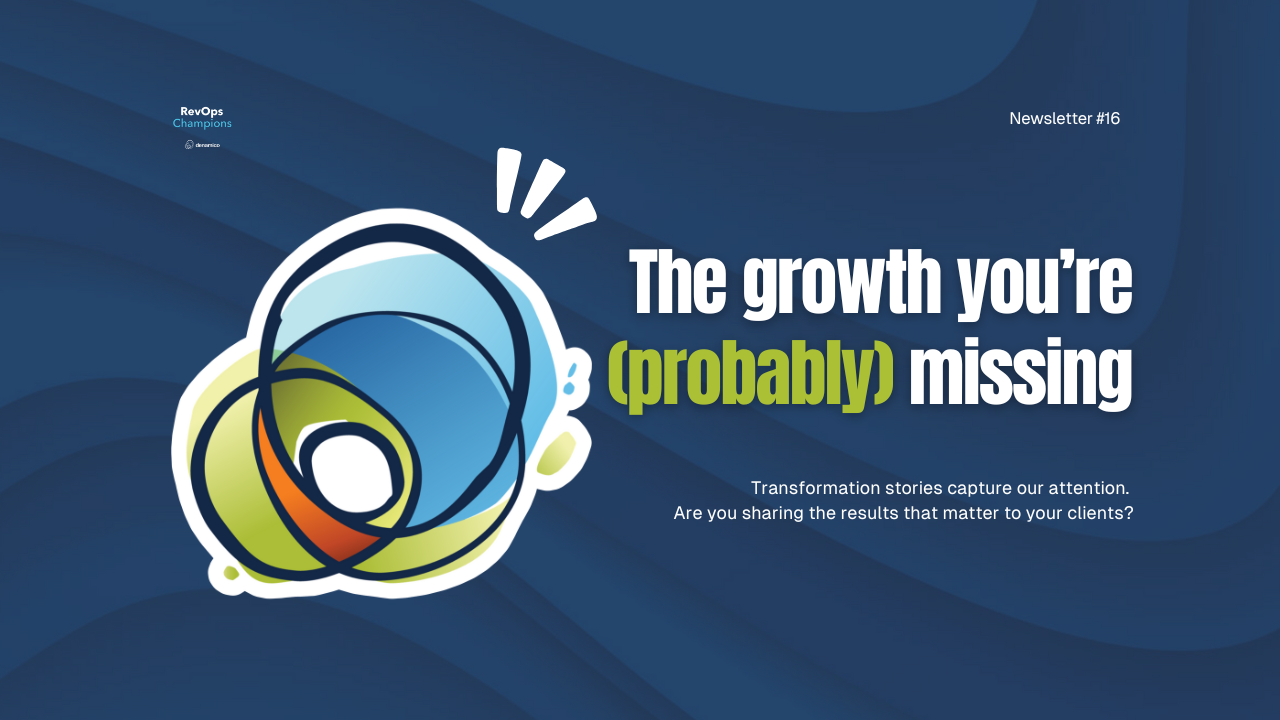RevOps Champions Newsletter #16
I’m a total sucker for a good before and after story. The subject doesn’t really matter.
It could be a fitness story, a house renovation, a hairstyle makeover, a business case study, or an investment analysis.
Research tells me that I’m not unique in that way. It’s probable that you also love transformation stories.
What is it about them that intrigues us?
I think…it’s because we all want to see results.
Most humans are naturally skeptical and we need to see that something is possible and that our efforts will be rewarded before we embark on doing the hard work. We want to understand what the delta was from beginning to end, in order to truly believe we could achieve those same results ourselves.
Achieving transformative results is usually not easy. They require time, hard work, and money.
I did a 6 week health program last year that focused on teaching the participants how to better balance our blood sugar. It required learning about macros, increasing my body’s alkaline level, understanding how protein, fiber, and carbohydrates work together, prioritizing sleep, doing the right balance of cardio and strength training and meditation. And I had to actually plan meals in advance 🤯 (not a natural strength of mine..)
It was hard work!
I often wondered if it was worth it.
But then I got the ‘after’ lab tests back.
Literally all of my markers had improved. I felt more energetic, I was sleeping better, my clothes fit better. The results were fantastic. Hard-earned, and worth the effort.
Knowing how psychologically powerful it is to show customers and prospective customers an amazing before and after, I’ve been wondering, how do we translate the equivalent of that to a B2B situation?
And then I listened to the RevOps Champions podcast with Daphne Costa Lopes and she helped answer my questions.
Daphne is the Global Director of Customer Success at HubSpot and hearing how she thinks about sharing results with customers made me realize the opportunity most companies have to do a better job of “showing” proof of their value to their customers. And it comes with a lot of financial upside.
Since Daphne is on the customer success side of the business, she’s focused on growing revenue through creating more value for customers.
As she shares in the podcast, “expanding a customer can be up to 25 times cheaper than gaining a new one.”
So what can we do to make expanding customer accounts easier?
Daphne says we need to quantify the value we provide them.
As she says, “You want to build on a foundation of value and a foundation that you can stand on, that you can shout about, that you can tell the market you're delivering on the promises. So make sure that you spend that time, no matter how hard it is.”
We live in a data-driven world and have analytics for everything. In some areas of a business, it’s very easy to quantify the results. For example, our CRM or marketing automation software tells us our conversion rates so we understand the results of a campaign. Sales people can quantify the dollar value of the revenue they’ve closed. Operations people can measure the revenue amount of the goods or services they’ve delivered.
But when we’re helping your customers solve complex or less tangible, albeit potentially very expensive, challenges, they can be quite difficult to measure.
I’ve seen a few SaaS companies like Slack and Clay do a good job of this. They’ve created an algorithm based on common use cases for their software which usually correlate to how much time is saved through doing that action in their application.
Then they apply that algorithm to the actual level of a user’s personal or team activity, to calculate things like how much time was saved through reduced meetings, increased collaboration, etc. And they share this ‘value’ with the user through a daily or weekly email update.
I am not sure what reporting on this would look like for Denamico, but we know most of our clients hire us because we help improve their operational efficiency and make it easier for them to grow revenue. Those numbers will be different for every client, but there should be a way for us to use some assumptions and quantify the value in some way. More to come on that…
But the bottom line (truly) is that it’s worth it for each of us to take the time to figure this out for our customers because once they understand that value, they’ll likely want to keep getting it, and to get more of it.
I’d love to hear if you’ve already done this in your business - and how it’s working out!
Cheers!
Kristin
 |
Kristin Dennewill
|

